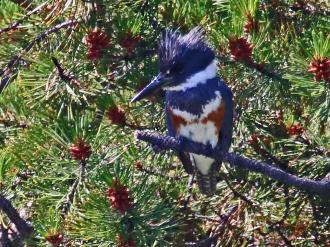Birds as Stakeholders
Submitted by Allen Dale on Wed, 2017-07-12 00:00
The first place we stopped today was the IBO below Lucky Peak on the Boise River. It was amazing and very heartwarming to see the volunteers and the number of kids that were there helping or just seeing what they do there. As Heidi explained what they were trying to see with their research and banding activities involved how many birds were nesting in the area and how many came back the next year after they migrated back to the area. I don't think that it was any coinsedence that the study are was along the Boise River. Water provides everything for the birds around that area. The insects that feed on the trees and plants that could not grow without the water provide from the river both directly and indirectly. Yesterday when we stopped at Mores creek for lunch I notices all of the fly catchers were really busy. There were Cedar Waxwings that were sitting on rocks in the middle of the creek. They would land and sit there and then fly up and flutter around a little and then return to the same spot, a typical behavior for fly catchers. They were hunting the insects that were emerging from the water.The trees the build their nesting in. The list is endless and can go so many directions. In a round about way the birds depend on Lucky Peak. Lucky Peak keeps the Boise River from flooding by keeping water back or releasing water. Some birds that nest very close to the ground could have their nests destroyed by flood waters. It is kind of funny to think of birds as stakeholders but they are really important stakeholders. Birds are the messengers to us when something in our environment is going wrong.
What other animals can you think of that could be considered stakeholders around the Boise watershed?


Comments
Birds as stakeholders
I am glad to see that you added birds to our list of stakeholders! I agree that they are very important indicators for ecosystem health.
Stakeholders
Thnak you for your post! As I read through everyone's posts this evening I can truly see the lines that connect all of us. The medium being used to connect us is the water. To watch as the group goes on these amazing adventures is so cool. I was totally unaware of the IBO and what is being done around the life source of these basins. If it is truly eye opening when you realize that over 50 plus spieces of birds are trapped and data collected on these stakeholders that count on the biome that we all share. Your question had me ponder about late winter drives I would take with my father around Lucky Peak to observe the Elk and Deer that roamed around the resivour. These too would be stakehokders. The fish that use our waterways and make their homes in these waters would also be included. Idaho is packed full of natural stakeholders that count on us to ensure these watersheds and the environment around them are here for generations to come.
Birds as Stakeholders
BTW, I love the pic you uploaded! Is that from this week?
When I was in MT visiting last month, I learned about the Osprey nest in Hellgate canyon. This year there were two babies that hatched. Right before I left the FWP announced that the two babies had starved to death. I couldn't understand how that had happened, there was such a great opportunity for fish so close to the Blackfoot river. I read the article and they had said that a lot of osprey along that river had struggled with hatchling mortality because of starvation. They said because there was such a large amount of snow pack in the mountains, the runoff period was longer than normal. This lead to the waters being higher and murkier than normal. Not good fishing conditions for the osprey. I never thought of it that way before. I figured that large amounts of snow and higher river flows would always be a good thing. I guess I was looking at it pretty selfishly. It made perfect sense once I stopped and thought about it.
Bird Behavior
Allen, I appreciate your knowledge about bird behavior. The "birds of Boise" are certainly the "canary in the coal mine" here in Southern Idaho. Another species that may indicate climate change are the antelope, prolific in the Salmon River Valley. Antelope travel quickly in small herds and can provide a visible clue regarding how the climate is shifting depending on their seasonal locations. Good question!